Whether you’re a beginner or an experienced fly fisherman, mastering nymph fishing techniques can greatly improve your catch rate. Nymph fishing is the most effective method for fly fishing for trout in streams and rivers. In this article, we will explore essential tips and techniques to help you become a successful nymph angler.
Key Takeaways:
- Learn the difference between nymph fishing and dry fly fishing.
- Get your nymph fly deeper to reach the trout’s feeding lane.
- Use a weighted fly to help it sink quickly and effectively.
- Set your strike indicator at the right depth for optimal results.
- Stay focused on the indicator to detect subtle trout strikes.
Understanding the Difference between Nymph Fishing & Dry Fly Fishing
When it comes to fly fishing, understanding the difference between nymph fishing and dry fly fishing is essential. These two techniques have distinct characteristics and are suited for different fishing conditions. Let’s explore the nuances of each approach.
Nymph Fishing Techniques
Nymph fishing involves imitating the subsurface stages of an insect’s life. Nymphs, which are aquatic insect larvae, inhabit the underside of rocks and cracks in streams and rivers. By using flies that mimic these nymphs, anglers can effectively target trout that feed below the surface.
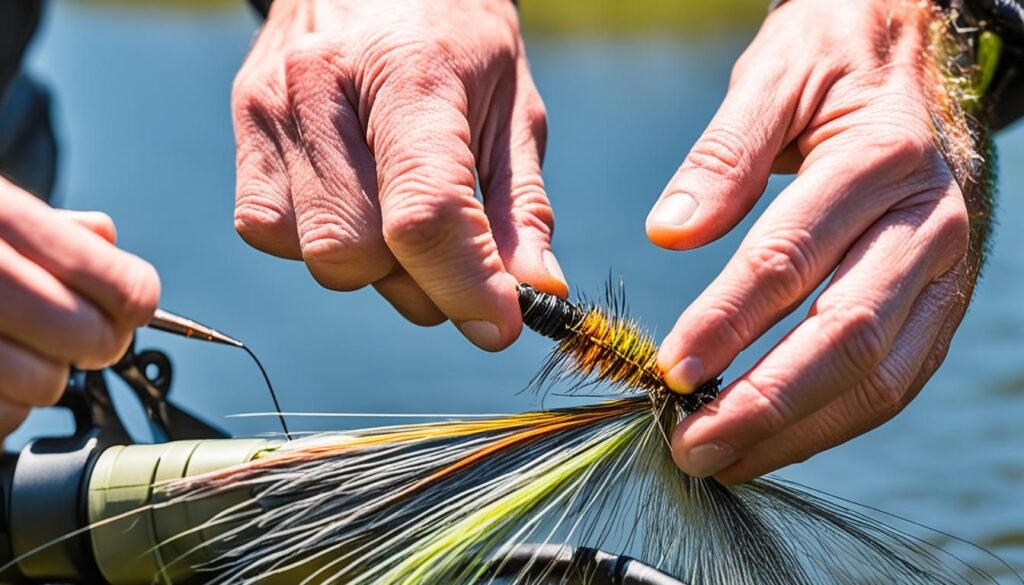
Dry Fly Fishing Techniques
Dry fly fishing, on the other hand, revolves around using flies that replicate the adult stage of an insect. These flies float on the water’s surface, mimicking an insect that has landed there. Anglers employ this technique when trout are actively feeding on insects that are visible on the water.
The Importance of Understanding the Difference
Knowing the distinction between nymph fishing and dry fly fishing is crucial because it allows anglers to adapt their strategies based on the prevailing conditions and the trout’s feeding behavior. If trout are predominantly feeding below the water’s surface, nymph fishing techniques will yield better results. Conversely, if trout are actively rising to feed on insects on the surface, dry fly fishing will be the preferred approach.
Understanding the difference between nymph fishing and dry fly fishing allows anglers to choose the right technique for the given situation, drastically improving their chances of success.
– Expert Angler, John Smith
As with any skill, practice and experience play a vital role in mastering both nymph fishing and dry fly fishing. By refining your casting techniques, developing a keen eye for trout behavior, and familiarizing yourself with the insect life cycle, you can enhance your effectiveness in both methods.
Getting the Fly Deeper
To effectively imitate the movements of subsurface insects and increase your chances of catching trout, it is crucial to get your nymph fly into the trout feeding lane. Trout typically feed in the bottom 6 to 12 inches of the water column, where the majority of nymphs are found. By getting your fly down to that depth, you can present it in the most natural way possible and entice trout to strike.
One of the key factors in getting your fly deeper is understanding the behavior of the trout. They tend to position themselves in areas where they have easy access to food, such as near the streambed or along the edges of structures. These areas are commonly referred to as feeding lanes, and targeting them increases your chances of success.
When nymph fishing, it’s important to consider the depth at which your fly is presented. By adjusting the depth of your nymph, you can effectively target the trout feeding lane. Here are some techniques to help you get your fly deeper:
- Weighted flies: Using a weighted fly is an effective way to get your nymph down quickly to the desired depth. The extra weight helps the fly sink faster, allowing you to reach the feeding zone of the trout.
- Adding weight to the leader: Adding split shot or other weight to your leader can also help get your fly deeper. By strategically placing the weight above the nymph fly, you can control the depth at which it fishes.
- Adjusting your leader length: Lengthening your leader can be another effective technique to get your fly deeper. By increasing the length of your leader, you allow for a longer drift, giving your fly more time to sink into the trout feeding zone.
Techniques to Get Your Fly Deeper
| Technique | Description |
|---|---|
| Weighted flies | Attach a fly with added weight to sink faster |
| Adding weight to the leader | Use split shot or other weight on the leader to control the depth |
| Adjusting leader length | Lengthen the leader to allow for a longer drift and deeper presentation |
Experiment with these techniques to find the best method for getting your nymph fly deeper. It’s important to adapt to the specific conditions of each fishing situation, such as current speed and depth, to effectively target the trout feeding lane.
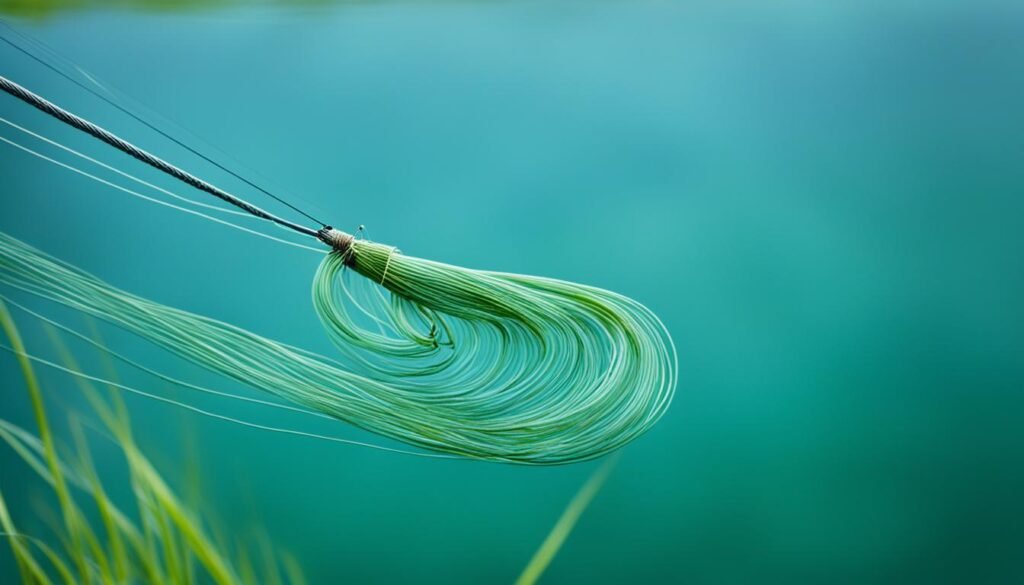
Using a Weighted Fly
When it comes to nymph fishing, getting your fly to sink to the bottom is crucial for success. Unlike dry fly fishing where the fly stays on the surface, nymph fishing requires your fly to reach the depths where trout are feeding. This is where using a weighted fly comes in handy.
A weighted fly helps your nymph sink faster, especially in fast currents or deep streams. The increased weight allows your fly to penetrate the water column quickly, reaching the desired depth where the trout are actively feeding. Not only does a weighted fly improve your chances of getting more bites, but it also ensures your fly remains in the strike zone for longer periods.
Two popular options for weighted nymph flies are beadhead patterns and tungsten flies. Beadhead nymphs feature a small metal bead near the head of the fly, providing additional weight and sinking capabilities. Tungsten flies, on the other hand, are made with tungsten beads that are denser and heavier than traditional metal beads, allowing them to sink even faster.
Benefits of Using a Weighted Fly:
- Quickly reaches the desired depth
- Stays in the strike zone for longer
- Increases the chances of getting more bites
- Effective in fast currents and deep streams
Using a weighted fly gives you an advantage when nymph fishing by allowing you to effectively target trout in their feeding lanes. Whether you’re fishing in swift rivers or deep pools, a weighted fly will help you get your nymph down where the fish are. Combine it with the right nymphing techniques, and you’ll be well on your way to a successful day on the water.
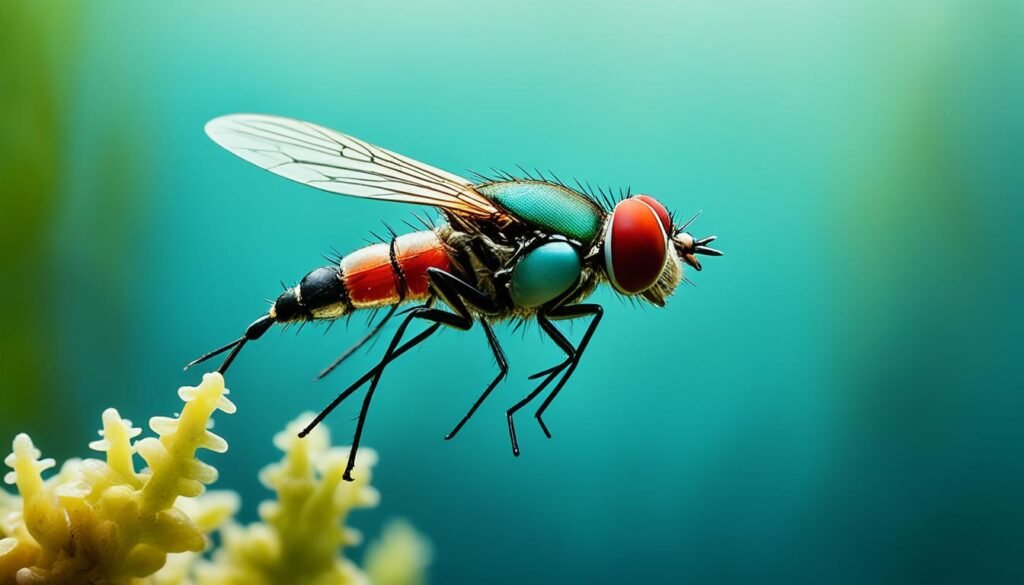
Setting Your Indicator High
When it comes to nymph fishing, the placement of your strike indicator is key. By setting your indicator higher on the leader, you can ensure that your nymph sinks deeper, where the trout are more likely to be feeding.
For fast currents in streams or rivers, it is recommended to set your indicator to approximately twice the depth of the water. This allows your nymph to reach the desired depth and increases your chances of enticing a strike.
However, in slower currents, some anglers prefer to set the indicator lower on the leader. This allows for more precise control and presentation of the nymph in the slower-moving water, where a higher indicator placement may cause the nymph to sink too quickly.
The Ideal Indicator Placement
To determine the ideal indicator placement, consider the speed of the current and the depth of the nymphing location. Take into account factors such as the flow rate, water depth, and the behavior of the trout in that particular area.
Using a combination of experience and observation, you can fine-tune your indicator placement to match the conditions and increase your chances of success. Remember, it’s all about finding the optimal balance between getting your nymph into the feeding zone and maintaining a natural presentation.
Experiment with different indicator placements to see what works best for you in different fishing situations. Every river and stream presents unique challenges and opportunities, so being adaptable and open to adjusting your tactics will help you become a more versatile and successful nymph angler.
| Current Speed | Ideal Indicator Placement |
|---|---|
| Fast | Approximately twice the depth of the water |
| Slow | Lower on the leader for precise control |
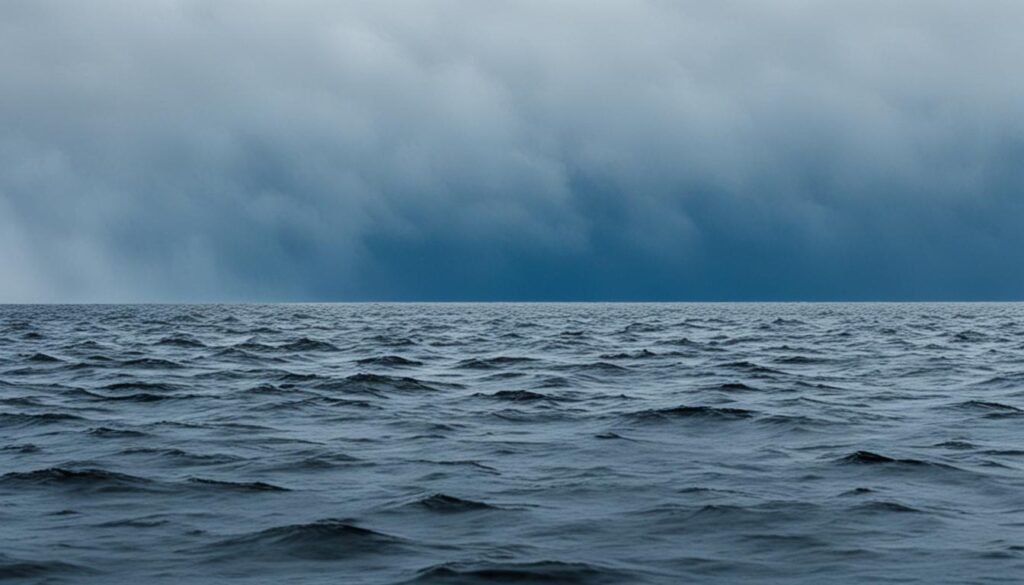
Staying Focused on the Indicator
When it comes to nymph fishing techniques, one of the most important aspects is staying focused on your indicator at all times. The indicator, also known as a strike indicator or bobber, plays a crucial role in detecting trout strikes. By keeping your eyes on the indicator, you can increase your chances of hooking the fish.
Trout strikes can be light and subtle, making it crucial to pay close attention to the indicator’s movements. Even a slight pull may indicate that a trout has taken the nymph. Therefore, it’s essential to keep a close eye on the indicator to ensure you don’t miss any potential strikes.
Proper indicator placement can significantly affect your ability to read and interpret its movements. Placing the indicator in a spot where you can easily see it and make quick judgments is key. Experiment with different indicator placements to find what works best for you in different fishing scenarios.
It’s worth noting that when a trout takes the nymph, the indicator may not sink violently or perform any dramatic movements. Instead, it may simply stop momentarily or move slightly to the side. Paying attention to even the subtlest changes in the indicator’s behavior can help you detect more trout strikes and increase your chances of success.
Remember, nymph fishing techniques require focus and attentiveness. By staying focused on the indicator, placing it strategically, and interpreting its movements accurately, you can improve your nymph fishing skills and catch more trout.
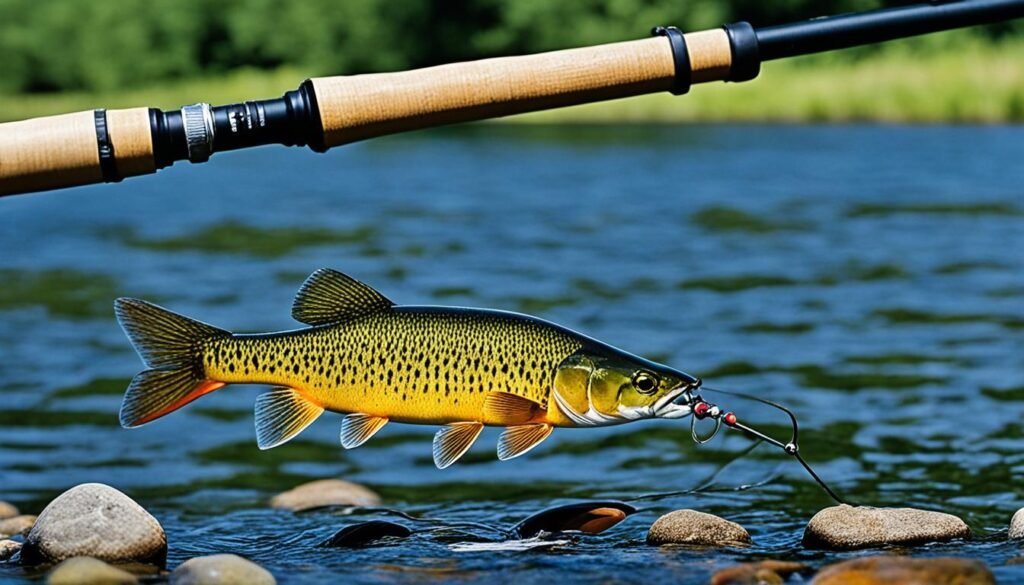
Staying focused on the indicator is crucial when nymph fishing. By diligently watching the indicator’s movements and accurately interpreting its subtle changes, you can detect trout strikes and increase your chances of hooking the fish. Keep your eyes locked on the indicator, experiment with placement, and be prepared for those gentle pulls that signify a trout’s interest in your nymph.
Striking at the Right Moment
Timing and technique are crucial when it comes to striking while nymph fishing. As soon as the indicator gives you a sign of a trout strike, you need to strike immediately. The strike should be swift but not overly forceful to avoid ripping the fly out of the fish’s mouth. Being prepared and striking at the first light pull will increase your chances of hooking the trout.
“A well-timed strike can be the difference between a successful catch and a missed opportunity.” – Expert Angler
To achieve a successful strike, follow these steps:
- Keep your rod tip low and close to the water to minimize slack in the line.
- Watch your indicator closely, as any unnatural movement or pause could indicate a trout strike.
- When the indicator moves or pauses, quickly lift your rod tip to set the hook.
- Keep the pressure on the line and fight the fish carefully to avoid snapping the tippet.
| Common Mistakes to Avoid | Tips for Success |
|---|---|
| Striking too late, giving the trout time to spit out the fly. | React quickly when you see any indication of a strike. |
| Using excessive force, which can tear the fly out of the fish’s mouth. | Strike with enough force to set the hook, but maintain control. |
| Looking away or losing focus on the indicator. | Keep your eyes on the indicator at all times to avoid missing strikes. |
Remember, the art of nymph fishing requires patience and practice. The more you hone your timing and technique, the more successful you’ll become at landing that prized trout.
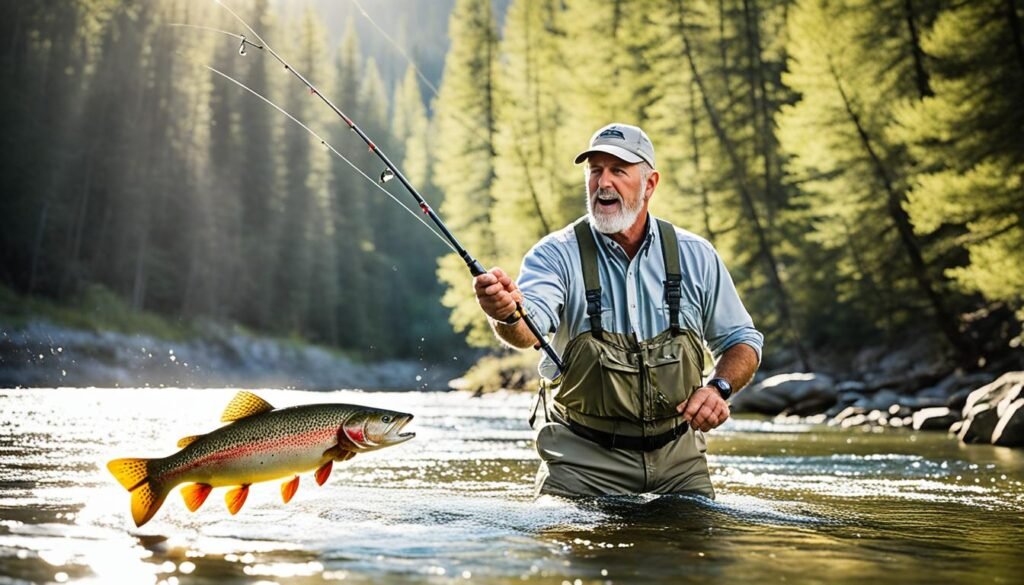
Varying Your Nymph Fishing Techniques
To maximize your success in nymph fishing, it is important to diversify your techniques. Nymph fishing is not a one-size-fits-all approach, as different situations and conditions may require different methods.
One popular variation is Euro-Nymphing, which involves using long leaders and minimal fly line for precise control. This technique allows you to get your nymph fly to the desired depth quickly and effectively.
Another effective technique is the dry dropper technique. In this method, a dry fly is used as an indicator for a subsurface nymph. This gives you the advantage of being able to both imitate surface insects and target fish at deeper depths.
By experimenting with different nymph fishing techniques, you can adapt to different fishing scenarios and increase your chances of catching more trout. Whether you choose Euro-Nymphing or the dry dropper technique, the key is to vary your approach and find what works best for you in different situations.
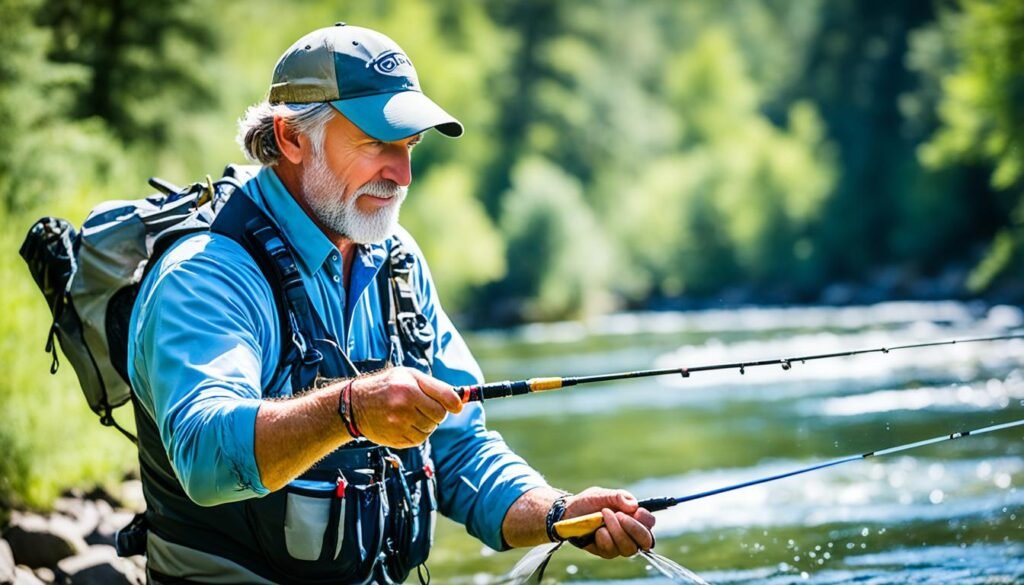
Pros and Cons of Euro-Nymphing and Dry Dropper Technique
| Technique | Pros | Cons |
|---|---|---|
| Euro-Nymphing |
|
|
| Dry Dropper Technique |
|
|
“By varying your nymph fishing techniques, you can adapt to different fishing scenarios and catch more trout. Don’t be afraid to experiment and find what works best for you!”
Conclusion
Nymph fishing is a fundamental technique that every trout angler should master. By understanding the nuances of nymph fishing and employing the right strategies, you can significantly enhance your chances of success on the water. Remember to focus on getting your fly deeper into the trout’s feeding zone, using weighted flies, and setting your indicator at an appropriate height. Staying vigilant and attentive to your indicator’s movements and striking at the right moment are also key to hooking more trout.
Additionally, don’t be afraid to experiment with different nymph fishing techniques such as Euro-Nymphing or the dry dropper approach. Varying your techniques allows you to adapt to different fishing scenarios and increase your catch rate. Always keep in mind that practice and experience are essential for becoming proficient in nymph fishing. Continually refining your skills will lead to greater confidence and an exciting fly fishing adventure.
So, whether you’re a beginner or a seasoned angler, make sure to incorporate these nymph fishing techniques into your trout fishing arsenal. With patience, perseverance, and a willingness to learn, you’ll be well on your way to mastering nymph fishing and enjoying the thrill of reeling in more trout. Tight lines and happy nymphing!
FAQ
What is the difference between nymph fishing and dry fly fishing?
Nymph fishing involves using flies that imitate the subsurface stages of an insect’s life, while dry fly fishing uses flies that replicate the adult stage of an insect and drift on the surface of the water.
How do I get my nymph fly deeper?
To get your nymph fly down to the feeding lane of trout, use a heavily weighted fly or beadhead patterns and tungsten flies to help it sink faster.
Where should I set my strike indicator for nymph fishing?
The placement of your strike indicator plays a crucial role in nymph fishing. Setting it higher on the leader can ensure that your nymph sinks deeper. For fast currents, set the indicator depth approximately twice the depth of the stream or river.
How should I stay focused on my indicator while nymph fishing?
To stay focused on your indicator, keep your eyes on it at all times. Place the indicator in a spot that you can easily read and interpret to maximize your success.
When should I strike while nymph fishing?
As soon as the indicator gives you a sign of a trout strike, you should strike immediately. The strike should be swift but not overly forceful to avoid ripping the fly out of the fish’s mouth.
What are some variations of nymph fishing techniques?
Some popular variations include Euro-Nymphing, where long leaders and minimal fly line are used for precise control, and the dry dropper technique, where a dry fly is used as an indicator for a subsurface nymph.

